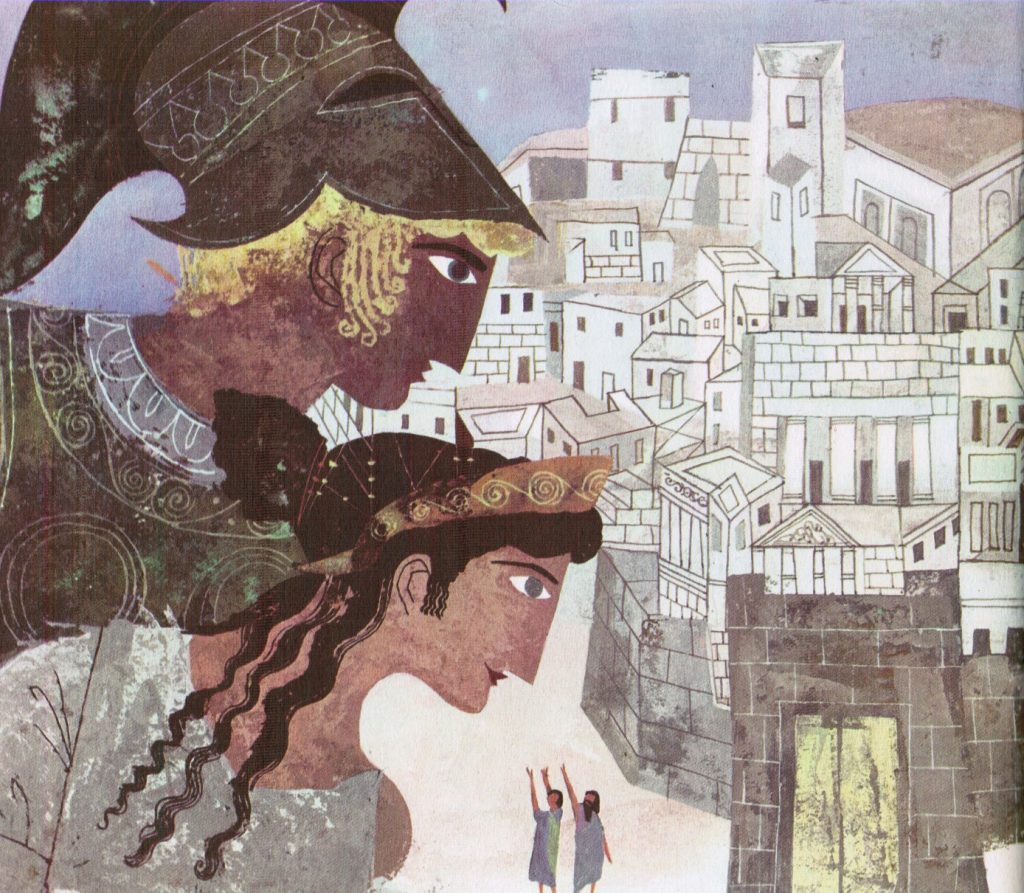
Art from The Iliad and the Odyssey: A Giant Golden Book adapted from the Greek classics of Homer by Jane Werner Watson and vividly illustrated by Alice and Martin Provensen
The legend of Troy has endured for more than 3,000 years, and continues to inspire artists and writer today. The story of a great city, plunged into a 10-year war over the abduction of the most beautiful woman in the world, is irresistibly dramatic and tragic. This allure has sent adventurers and archaeologists in quest of the lost city, which is now widely believed to have existed.
But what of the heroes and the heartbroken, the women and the wanderers, who are said to have a played a part in the Trojan War? Why have they inspired so many retellings, from Homer to Shakespeare, Hollywood, books and comics?
The myth certainly captured me as a youngster, big time, thanks largely to early exposure to The Iliad and the Odyssey: A Giant Golden Book by husband and wife team Alice and Martin Provensens, with its memorable illustrations of both scenes from the mythical Trojan War and the hair-raising adventures of Odysseus and crew on their long journey home, post war.
Just as it enraptured audiences in the past, the legend of Troy and the Odyssey still speaks to us today, through more recent adaptations such as the Gareth Hinds’ The Odyssey, published in 2010 and his more recently-published comics telling of The Iliad, released earlier this year.
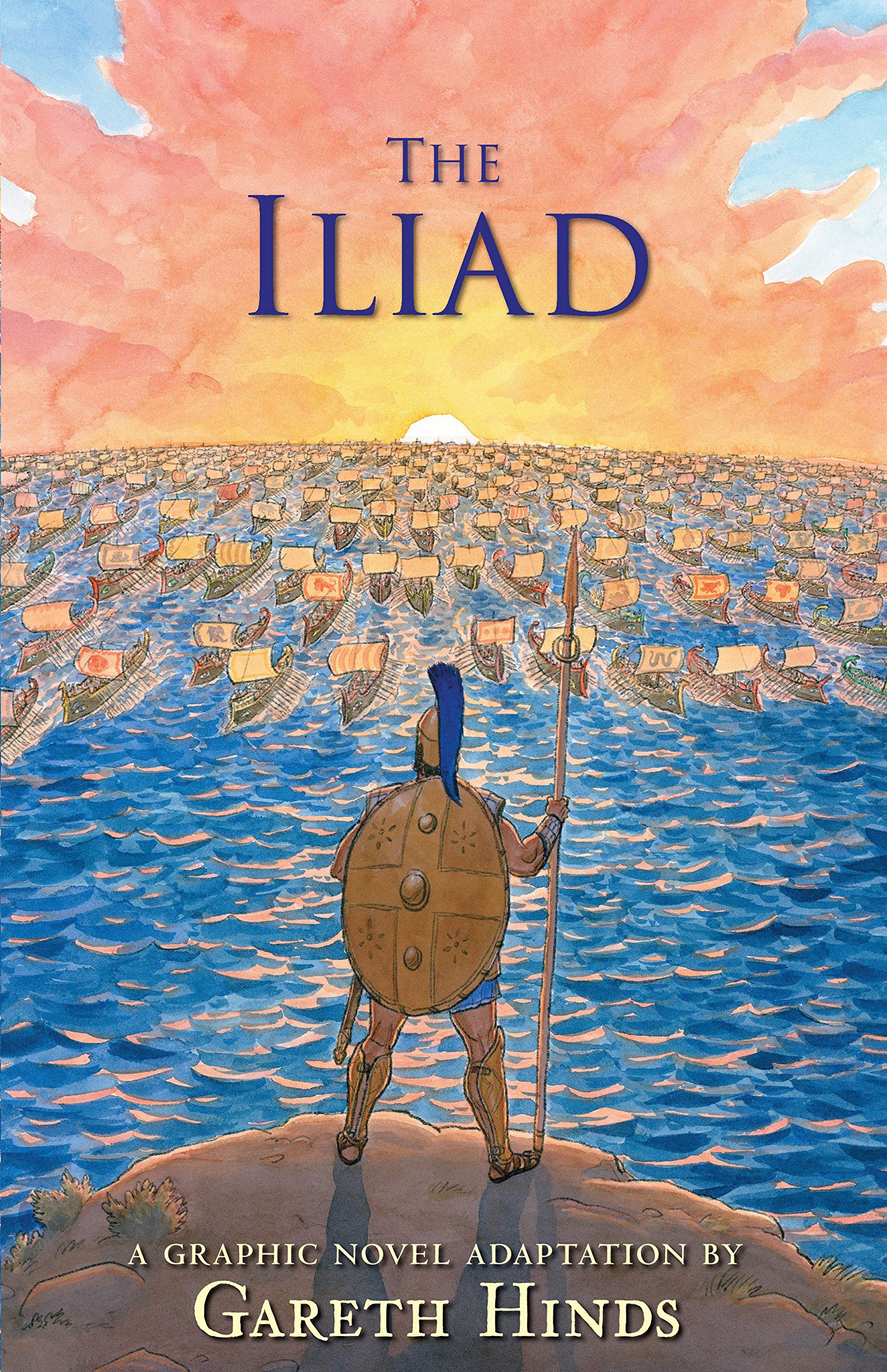
The Iliad by Gareth Hinds, a graphic novel, was published earlier this year by Candlewick Press
Even though the Latin lessons I had at school were often some of the most chaotic of the day, I’m glad now that thanks to the much put-upon Mr Rower, our teacher, I had the opportunity read the the Latin version of Homer’s epic poem as well as the “Golden Book” version, and the story helped encourage my love of history and research that I’ve tried to apply to my writing my whole life.
The legend even briefly powered aspirations to be an archaeologist, extinguished by the frankly dull teaching of the subject during my first year at university, that bore no relation whatsoever to either the brilliant teaching of history I had at school or the experience of the one archaeological dig I took part in as a teenager at Launceston Castle in Cornwall.
Now you can explore the reality behind one of history’s greatest myths in the British Museum’s major Troy Exhibition, and get closer to some legendary characters, with an opportunity to explore the breath-taking art that brings them to life – from dramatic ancient sculptures and exquisite vase paintings to powerful contemporary works.
You can also examine the fascinating archaeological evidence that proves there was a real Troy – and offers tantalising hints at the truth behind the mythical stories such as Helen of Troy’s abduction, the Trojan Horse and the fall of the city.
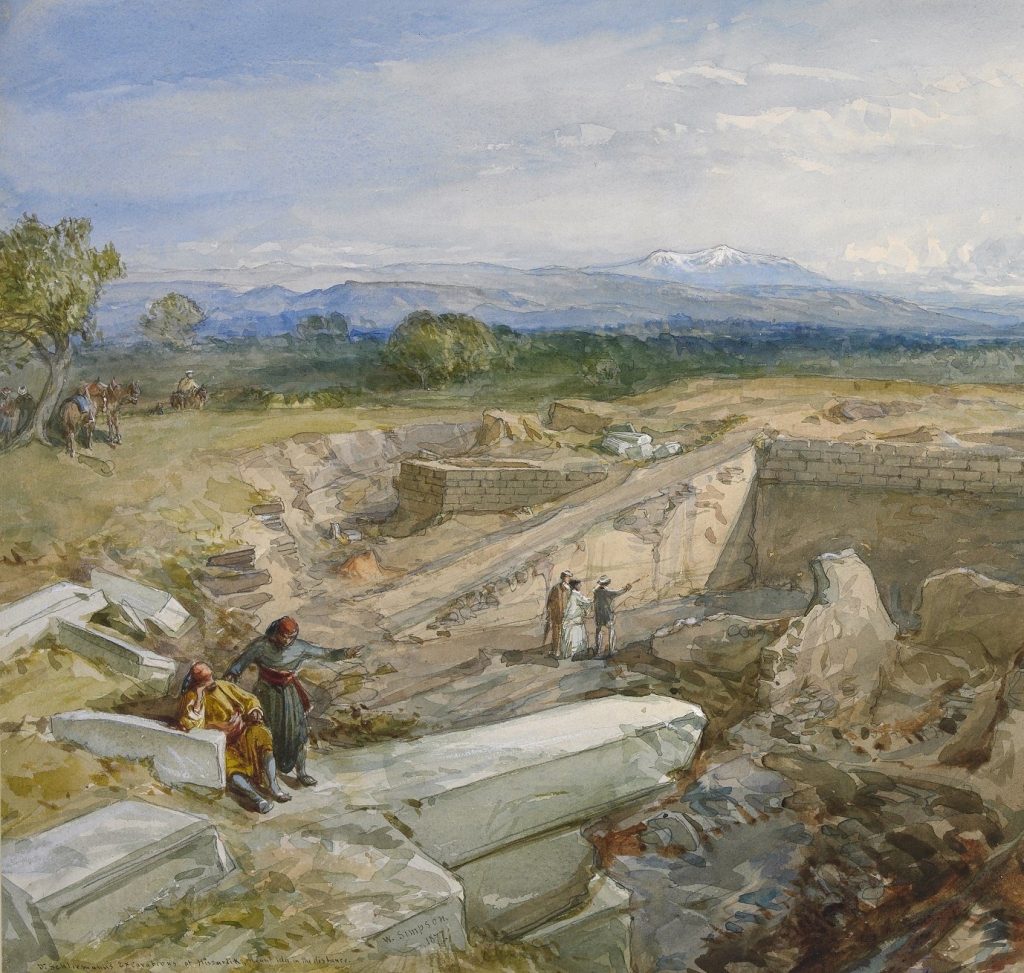
William Simpson, Excavations at Hissarlik. Watercolour, 1877
For centuries, the site of Troy was lost to time. It was thought to be located in an area of northwest Turkey called the ‘Troad’ – and countless people travelled there to stand on the ground where they believed heroes once walked.
But it wasn’t until the 19th century that the exact location of Troy was revealed. In 1870, self-taught archaeologist Heinrich Schliemann travelled to the Troad, aiming to prove that the myth of the Trojan War was based on fact.
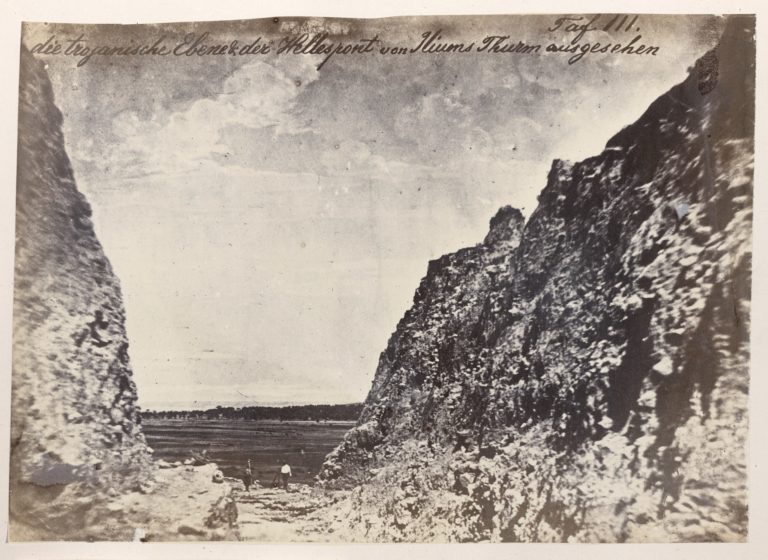
In 1873, Heinrich Schliemann dug a huge trench right through the centre of the mound of Troy. This showed that the mound was made up of the layers of successive settlements
Although no evidence can confirm the epic battle really happened, experts now agree that the area Schliemann excavated is the true site of Troy.
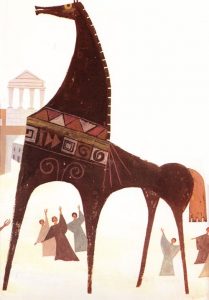
Art from The Iliad and the Odyssey: A Giant Golden Book adapted from the Greek classics of Homer by Jane Werner Watson and vividly illustrated by Alice and Martin Provensen
The story of the ancient city of Troy, and of the great war that was fought over it, was spread by travelling storytellers, cast into powerful words by the Greek poet Homer as early as the eighth to seventh century BC – and into powerful images by ancient Greek and Roman artists.
The legend it Troy is a story that has it all – love and loss, courage and passion, violence and vengeance, triumph and tragedy – on a truly epic scale. I’m hoping this exhibition reflects all that and will be aiming to see it when I can.
• Book tickets for the British Museum’s Troy Exhibition here
• Discover more about the search for a lost city in the British Museum curators’ blog
WEB LINKS
• Brain Pickings has a number of articles on the work of artists Alice and Martin Provensen
Few artists have done more to enchant generations of children with storytelling than wife-and-husband duo Alice and Martin Provensen, whose vibrant mid-century illustrations span everything from classic fairy tales to an homage to William Blake. Born on 14th August 1917, Alice ploughed through the era’s tragic bias against female artists; she survived Martin, who died in 1987, by more than two decades and continued to draw well into her nineties, dying in 2018
• An Appreciation of the The Iliad and the Odyssey Golden Book by Laura Bernhardt
• Find books illustrated by Alice and Martin Provensen on AmazonUK (Affiliate Link)
• Glorious Flights: The Illustration Art of Alice and Martin Provensen
Glorious Flights: The Illustration Art of Alice and Martin Provensen was exhibited at the National Center for Children’s Illustrated Literature (NCCIL) in autumn 2015. The exhibition, curated by Leonard Marcus, one of the world’s leading writers about children’s books and the people who create them, featured original art from the award-winning husband-wife team of Alice and Martin Provensen
• The Legend of Troy books on AmazonUK (Affiliate Link)
The founder of downthetubes, which he established in 1998. John works as a comics and magazine editor, writer, and on promotional work for the Lakes International Comic Art Festival. He is currently editor of Star Trek Explorer, published by Titan – his third tour of duty on the title originally titled Star Trek Magazine.
Working in British comics publishing since the 1980s, his credits include editor of titles such as Doctor Who Magazine, Babylon 5 Magazine, and more. He also edited the comics anthology STRIP Magazine and edited several audio comics for ROK Comics. He has also edited several comic collections, including volumes of “Charley’s War” and “Dan Dare”.
He’s the writer of “Pilgrim: Secrets and Lies” for B7 Comics; “Crucible”, a creator-owned project with 2000AD artist Smuzz; and “Death Duty” and “Skow Dogs” with Dave Hailwood.
Categories: Art and Illustration, British Comics, downthetubes Comics News, downthetubes News, Events, Other Worlds
 Whose Side Are You On? Election Trail at London’s Cartoon Museum
Whose Side Are You On? Election Trail at London’s Cartoon Museum  Dan Dare curiosity included in Adam Partridge auction today
Dan Dare curiosity included in Adam Partridge auction today  Early “Dan Dare” from Eagle by Frank Hampson goes under the hammer next week
Early “Dan Dare” from Eagle by Frank Hampson goes under the hammer next week  More Leo Baxendale “Super Comic” artwork surfaces?
More Leo Baxendale “Super Comic” artwork surfaces?